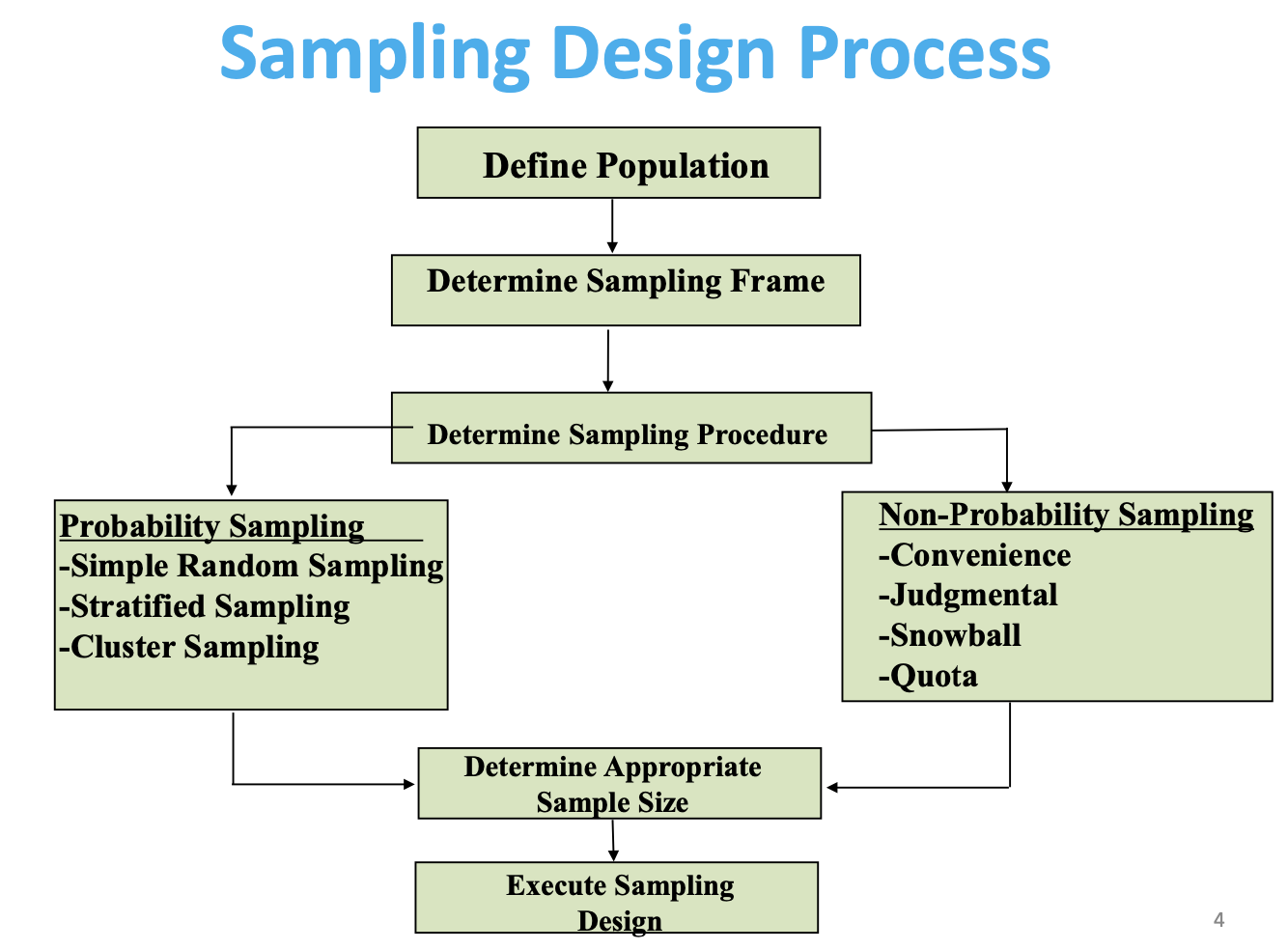lecture 4 - sampling and cohort studies
1/22
There's no tags or description
Looks like no tags are added yet.
Name | Mastery | Learn | Test | Matching | Spaced |
|---|
No study sessions yet.
23 Terms
what must studies do to figure out who is included in the study?
define a study sample
define sample
a selected subset of a population. sampled individuals must be at risk for the disease and representative of the population to which you want to apply the study findings.
sampling design process

what is probability sampling and what are some examples?
equal chance of being included in the sample (random)
simple random sampling
systematic sampling
stratified sampling
cluster sampling
what is non-probability sampling and what are some examples?
unequal chance of being included in the sample (non-random)
convenience sampling
judgment sampling
snowball sampling
quota sampling
what is simple random sampling (SRS)
population members are selected directly from the sampling frame
equal probability of selection for every member (sample size/population size)
use random number table or random number generator
what is systemic sampling?
order all units in the sampling frame based on some variable and number them from 1 to N
choose a random starting place from 1 to N and then sample every k units after that
what is stratified sampling?
the chosen sample is forced to contain units from each of the segments, or strata, of the population
equalizing "important" variables
year in school, geographic area, product use, etc.
steps:
population is divided into mutually exclusive and exhaustive strata based on an appropriate population characteristic (e.g. race, age, gender etc.)
simple random samples are then drawn from each stratum
what is cluster sampling?
clusters of population units are selected at random and then all or some randomly chosen units in the selected clusters are studied.
steps:
population is divided into mutually exclusive and exhaustive subgroups, or clusters. Ideally, each cluster adequately represents the population.
a simple random sample of a few clusters is selected.
all or some randomly chosen units in the selected clusters are studied.
what are the advantages of non-probability sampling?
cheaper and faster than probability
reasonably representative if collected in a thorough manner
what is convenience sampling?
a researcher's convenience forms the basis for selecting a sample.
students in my classes
my friends and family
people that I see
people who contact me
what is judgement sampling?
a researcher exerts some effort in selecting a sample that seems to be most appropriate for the study.
what is snowball sampling?
selection of additional respondents is based on referrals from the initial respondents.
friends of friends
used to sample from low incidence or rare populations.
what is quota sampling?
the population is divided into cells on the basis of relevant control characteristics.
a quota of sample units is established for each cell.
50 women, 50 men
a convenience sample is drawn for each cell until the quota is met (similar to stratified sampling)
probability vs non-probability sampling
non-sampling is less time consuming and less expensive
quantitative generalizations about populations can only be done under probability sampling
define non-response
nonresponse may turn any probability design into a nonprobability design if the characteristics of nonresponse are not well understood.
define cohort study
in a cohort study, a group of healthy people (cohort) is identified and followed over a certain time period to ascertain the occurrence of health-related events in order to investigate if the incidence of an event is related to an exposure.
what is the basic cohort approach?
1. cohort defined and sampled
2. participants are observed to ascertain exposure status (baseline)
3. time passes
4. participants are re-observed to ascertain outcome status (follow-up)
what is relative risk?
measure of association between exposure and outcome; risk of disease given an exposure
RR = probability of event in exposed: probability of event in unexposed
RR = incidence of disease in exposed : incidence of disease in unexposed
how do you interpret relative risk?
relative risk typically expressed with 95% CI
RR > 1 = disease more likely in exposed
RR < 1 = disease less likely in exposed
what are the two types of cohorts
prospective cohort
outcomes have not occurred when study commences
retrospective cohort
outcomes have already occurred
cohort defined by existing records, i.e., medical charts, administrative data
danish immunization studies
less costly but less flexible
what are the strengths of a cohort study?
estimate incidence and risk = stronger evidence for causal inference
temporal relationships can be clearly observed
ideally, exposures are randomly assigned; new methods to strengthen causal inference
more statistical power = greater precision of effect measures
repeated measures can reduce bias
possible to model ID trajectories (i.e., susceptible, infected, recovered)
possible to simultaneously model host/agent/environment interactions
what are the weaknesses of a cohort study?
loss to follow-up
difficulty of consistent data collection over time
accounting for missing data
time and cost especially for rare outcomes
longitudinal studies: standard regression models not usable